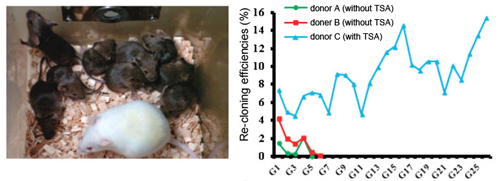| RIKEN Center for Developmental Biology (CDB) 2-2-3 Minatojima minamimachi, Chuo-ku, Kobe 650-0047, Japan |
March 10, 2013 –Since the first reports of successful cloning of mammals by somatic cell nuclear transfer, concerns have been raised about the efficiency and repeatability of cloning techniques, and the health of cloned offspring. Although it has been showed since the early 2000s that cloned animals can themselves be cloned, the efficiency of SCNT appeared to taper with each successive generation, leading some to speculate that there might be an inherent limit to cloning from clones due to the accumulation of genetic errors. Now, however, a new report by the Laboratory for Genomic Reprogramming (Teruhiko Wakayama, Team Leader) shows that mice can be cloned successively for at least 25 generations. Published in Cell Stem Cell, this work by Wakayama, now at the University of Yamanashi, suggests that there is no inherent limit to SCNT repeatability, given sufficiently efficient methods.
The team used four genotyped female mice as its starting set of nuclear donors, removing the genetic material from cumulus cells for use in SCNT attempts, giving rise to a number of cloned offspring. Donor mice that showed the greatest ability to give rise to first generation clones was selected to serve as the donor for the subsequent serial cloning experiment, which began in late 2005. For each successive generation, cumulus cells were obtained from 3-month-old mice and used as donor cells for the next round. Wakayama found that the efficiencies varied by generation, ranging from 4–5% in early rounds to more than 20% in later generations, including the 25th (G25), the last generation reported. Some of this variation may be attributable to improvements in cloning technology that emerged during the study period. During this lengthy investigation, which gave rise to more than 500 viable cloned offspring, the team examined whether complete matching of donor nuclei with recipient oocytes would boost efficiency, but they found that even microinjection of donor somatic nuclei into oocytes from the same animal did not result in a higher success rate, suggesting that, in principle, heterogeneous donors are equally capable of giving rise to clones. Cloned offspring in some species have shown a range of developmental and health defects. In mice, clones have been observed to have enlarged placentas (placentomegaly). In the 25-generation series, however, the body weights of the cloned offspring remained consistently within the normal range for wildtype animals, while placentas were two- to three-fold heavier. This effect did not increase with higher generations suggesting that the abnormality that underlies this phenomenon is not cumulative. Fertility is another measure of the health status of cloned animals. Wakayama randomly selected four animals from the 20th generation of the series and mated them with mice that had not been cloned, and found that all four were fertile and gave birth to healthy litters of pups. The lab also conducted tests of telomere lengths and gene expression patterns in the cloned mice, While no shortening of telomeres was observed even in later generation clones, there were differences in the expression of some genes. But again, these resembled differences observed in non-serially cloned control animals, and did not appear to change from generation to generation. One key element of the cloning technique appears to be the addition of a reagent known as trichostatin A to the cell medium, which has previously been shown to raise SCNT efficiency by approximately double. In G20 cloning efforts, the team compared SCNT with and without trichostatin, and found that the effect on reprogramming remained the same. “This series of experiments is exciting because it reveals how, with the right techniques, clones can continue to be made even after the death of the original donor animal,” says Wakayama. |
|||||||
|
|||||||
|
|||||||
 |
| Copyright (C) CENTER FOR DEVELOPMENTAL BIOLOGY All rights reserved. |
